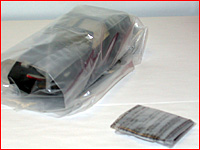
Tip for December 2004:
Safe Shipping
- First, put the model in a plastic bag, like the ones found in any new model. This will prevent packing material from rubbing against the paint and leaving scratches. If there are any loose pieces (like the hood), bag those separately.
- Second, wrap the bag(s) in a soft, cushioned sheet. Soft tissue paper, bubble wrap, or soft cloth work best - just make sure the model is thoroughly cushioned.
- Finally, "float" the wrapped model in the box using foam peanuts or air cushions. Try to keep at least two inches (5cm) of cushion between the model and the box wall on every side. This includes above the model - make sure to fill the box up to the top with packing material before you seal it. Otherwise, the model will have room to move and will be against a box wall in no time.
- If the model will be traveling long distance, or for extra security, pack this box inside another, larger box with an additional cushion layer.
- Never tie your model down! It may seem like it makes the model more secure to be anchored to something, but in reality it just creates a hard surface for the model to be smashed against.